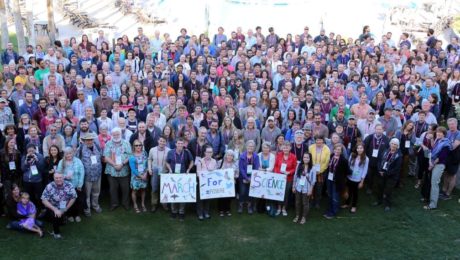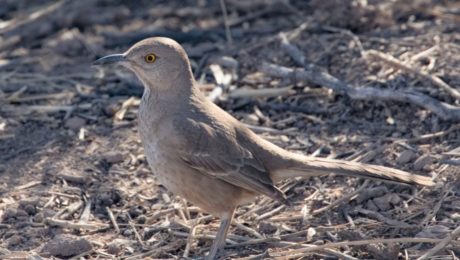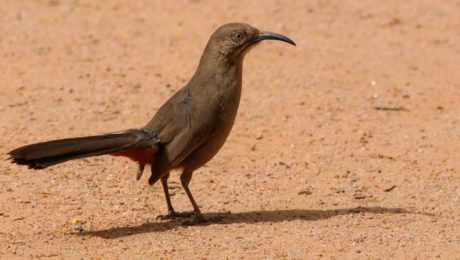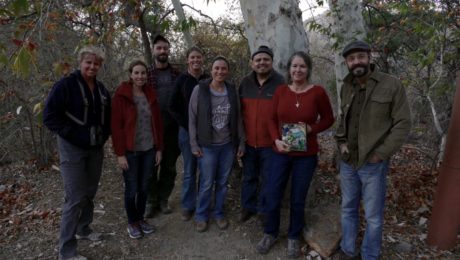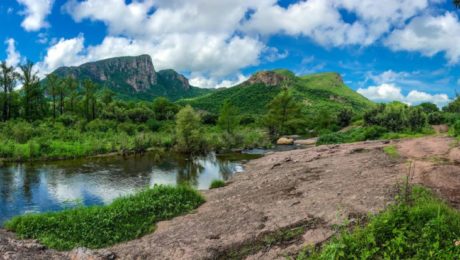Desert Birds Binational Symposium
The Sonoran Joint Venture helped coordinate the annual meeting of the American Ornithological Society, held in Tucson, Arizona in April. The meeting’s theme Celebrating Connections: Birds Across Borders, was the perfect opportunity for the SJV to co-lead a special symposium on binational collaboration for desert bird conservation.
- Published in Awards Program, News
Soar higher with LightHawk
LightHawk is teaming up with the Sonoran Joint Venture to accelerate conservation success through the powerful perspective of flight. LightHawk is a non-profit organization that mobilizes volunteer pilots, photographers, environmental experts, and storytellers to make images, collect data, inform the public and share their experiences.
- Published in News
Movements of Sandhill Cranes
With rapidly growing development of wind energy and its associated infrastructure, future impacts on wildlife are poorly understood. Biologist (and SJV board member!) Dan Collins, along with many partners, are working to better understand the movements of the Western Greater Sandhill Crane to inform agencies and land managers on where to target wintering landscapes for conservation.
- Published in News
Threats to Thrashers of the Desert Southwest
Two of the fastest declining species in desert habitats are Bendire’s Thrashers and LeConte’s Thrashers. Little is known about these species, which limits the effectiveness of conservation and management actions. The Desert Thrasher Working Group is aiming to change that through a multi-state monitoring program.
- Published in News
The American Ornithological Society Meeting Comes to Tucson
The annual meeting of the American Ornithological Society will take place at the El Conquistador Resort in Tucson, Arizona, April 9-14, 2018. The meeting’s theme is Celebrating Connections: Birds Across Borders, and sessions will place special emphasis on research and conservation. The Sonoran Joint Venture is co-coordinating two symposiums at the conference, one of which is free and open to the public.
- Published in Meetings and Events, News
Wildlife Field Guide to Sweetwater Wetlands, Tucson AZ
We are excited to announce the publication of a new iBook, the Sweetwater Wetlands Wildlife Field Guide. The SJV worked with our partners at The Environmental Education Exchange to help produce this interactive digital guide for Sweetwater Wetlands. Learn more and download your free copy!
- Published in News
Avicaching Comes to the Southwest
Looking for an exciting resolution to get 2018 off to a good start? Welcome the New Year by trying your hand—along with your eyes and ears—at Avicaching! Created by the Cornell Lab of Ornithology, Avicaching is simply eBird + Geocaching: searching specific locations to spot as many birds as possible. With geocaching, people go to specific sites to find small treasures. With Avicaching, eBird Hotspots are the locations and the birds are the treasures. But it’s not just a game. The data collected by Avicachers fills in gaps in knowledge and help guide management and conservation decisions. The SJV and our partners are launching the first Desert Avicaching game to learn more about southwest birds. That’s where YOU come in!
- Published in News
Bon Voyage to SJV Science Coordinator Carol Beardmore
On December 31, 2017, the Sonoran Joint Venture bid farewell to long-time Science Coordinator, Carol Beardmore, who retired after a 27-year career with the U.S. Fish and Wildlife Service and more than forty years working in conservation. Carol joined the SJV staff in 2003. Over the ensuing fourteen years, she developed the strong biological foundation that guides our bird and habitat conservation efforts, created the SJV Science Working Group (formerly the Technical Committee), and has been a driving force for Coordinated Bird Monitoring throughout the SJV region, and especially in Arizona.
- Published in News
Monte Mojino Reserve, Álamos Sonora
Nature and Culture International’s Monte Mojino Reserve has grown from a small reserve to 6,800 ha of tropical deciduous forests, riparian forests, and pine-oak forests covering about 10% of the total area of the Cucujaqui River watershed. Because of its location in the western Sierra Madre where the neartic zone meets the neotropical zone, the area is very biologically diverse, and home to over 200 species of birds. Next year, with funding from the SJV and in collaboration with researchers from the region, NCI will start a more in-depth study regarding habitat use and requirements of cavity-nesters in Monte Mojino Reserve.
- Published in News
SJV Awards Program Enables Expansion of Cuckoo Research in Mexico
Thanks to the Sonoran Joint Venture’s Awards Program, the Southern Sierra Research Station facilitated a Western Yellow-billed Cuckoo survey training workshop for Mexican biologists to lead surveys in Northwestern Mexico. Researchers and students from the University of Sonora, Sonora State University, the Ecological Center of Sonora, and the Ecology and Sustainable Development Commission of the State of Sonora, had the opportunity to learn about the biology and ecology of the Western Yellow-billed Cuckoo, as well as the methodology to carry out surveys for this species during the workshop held in Hermosillo, Sonora, in 2017.
- Published in News


 English
English  Español
Español 